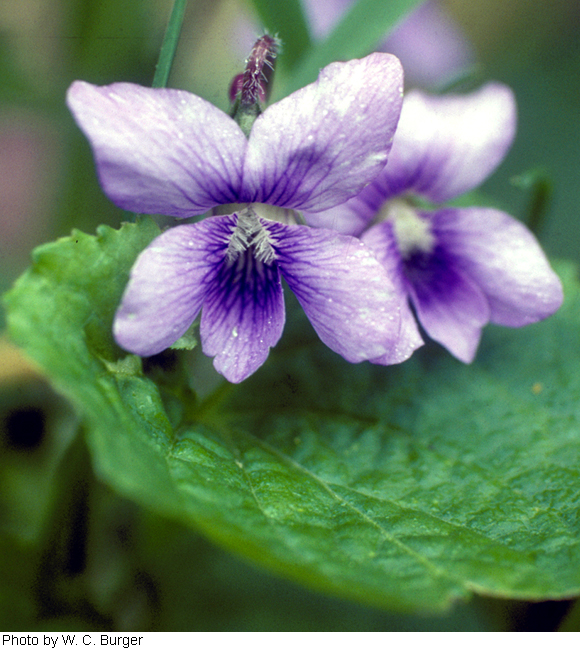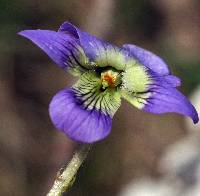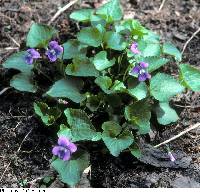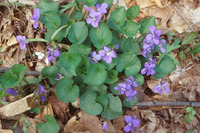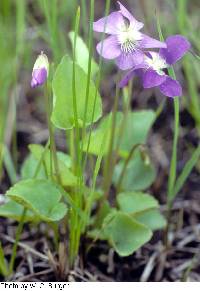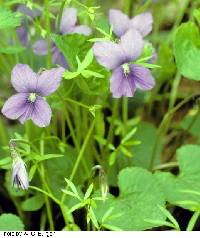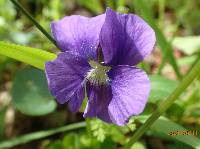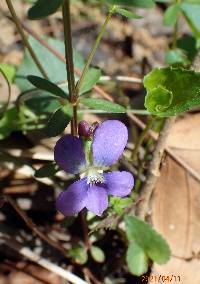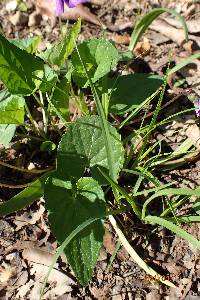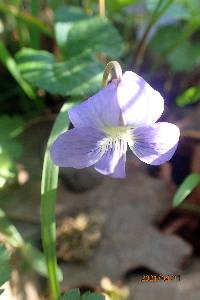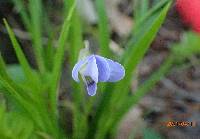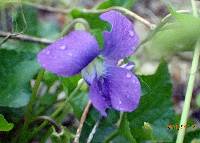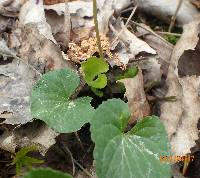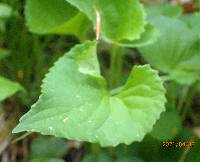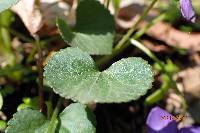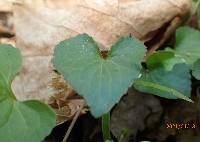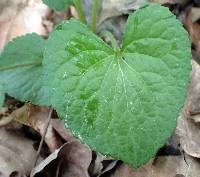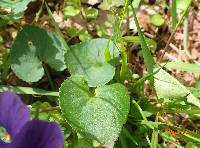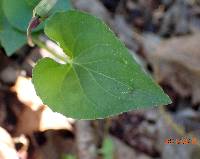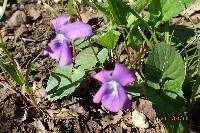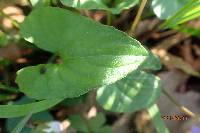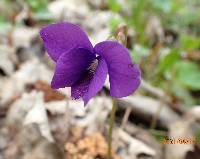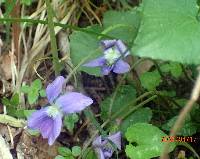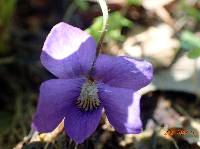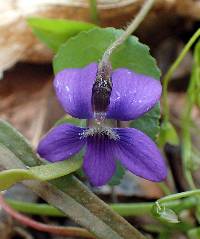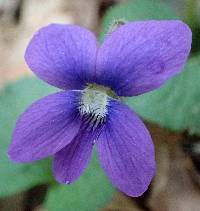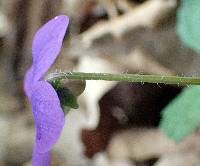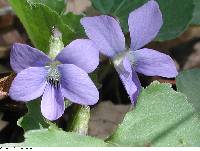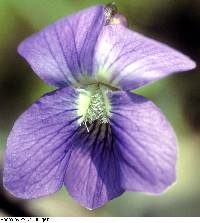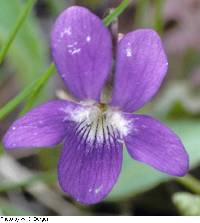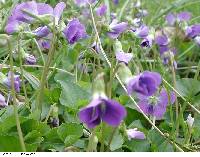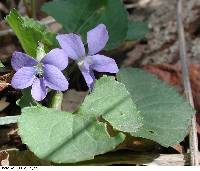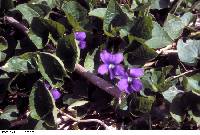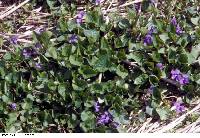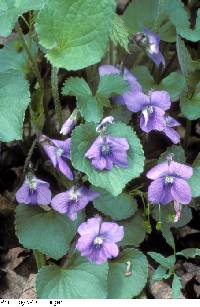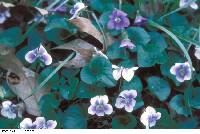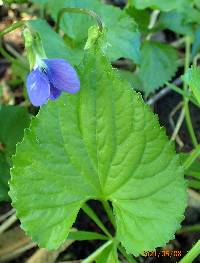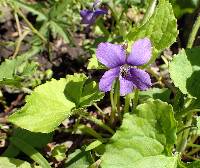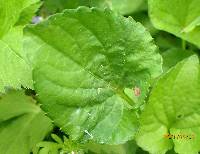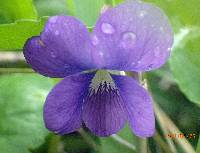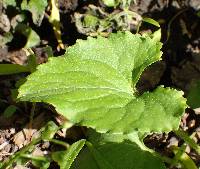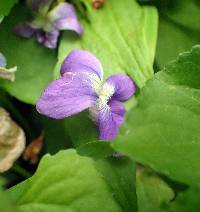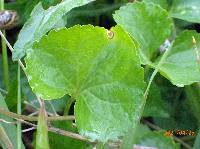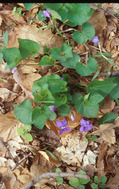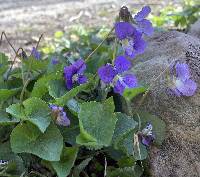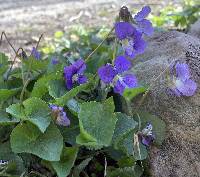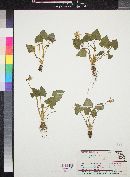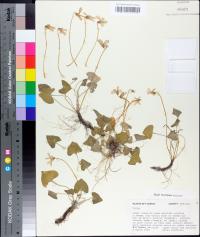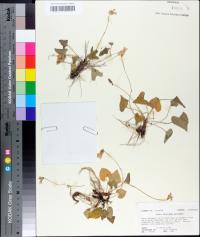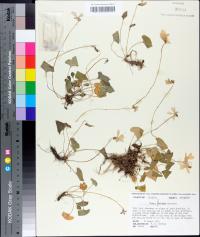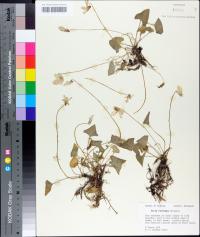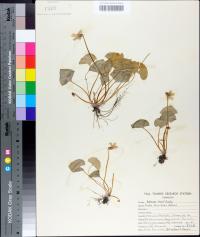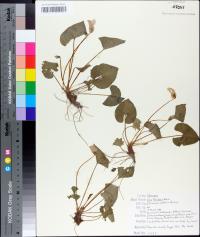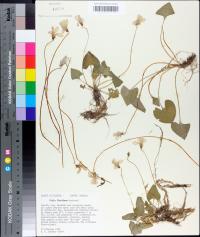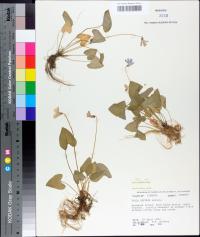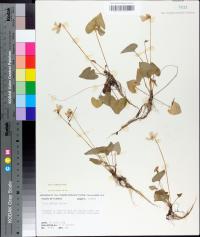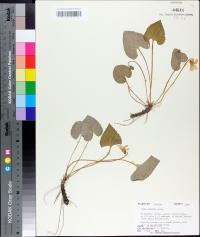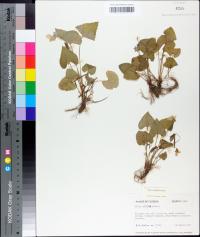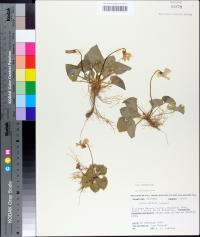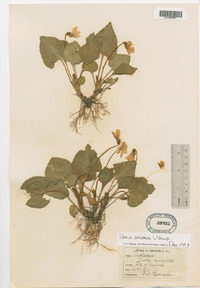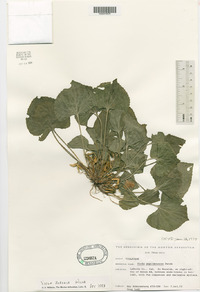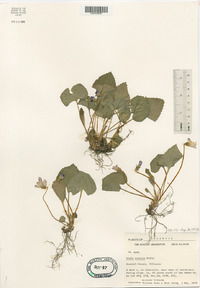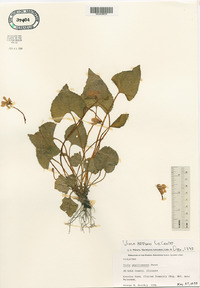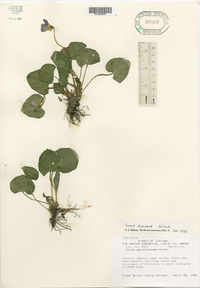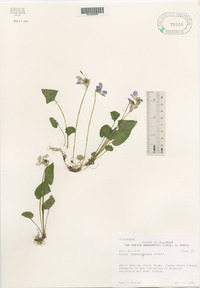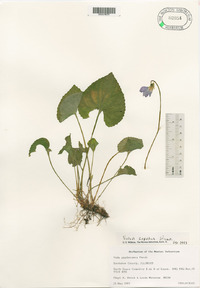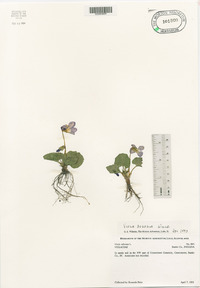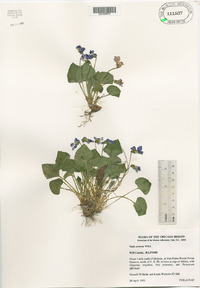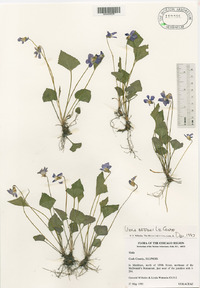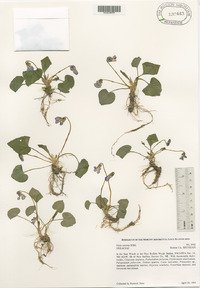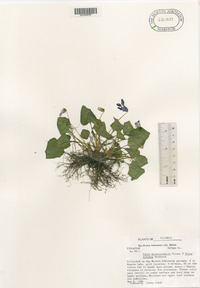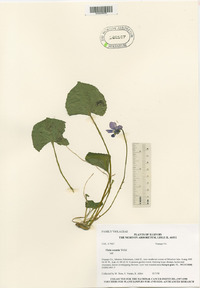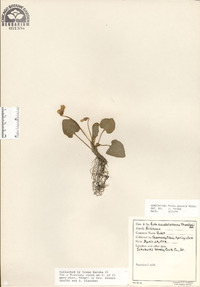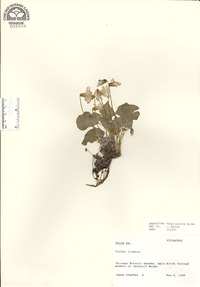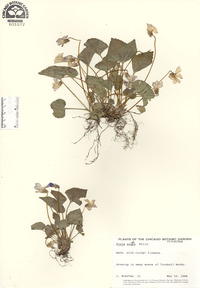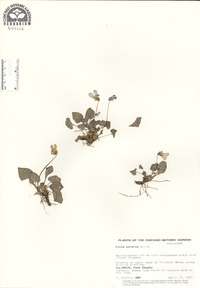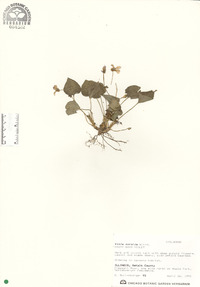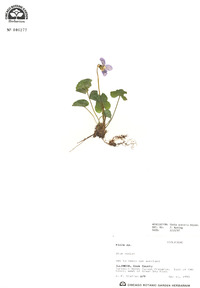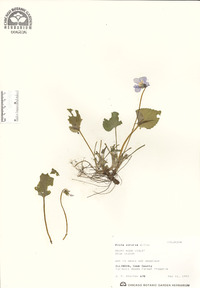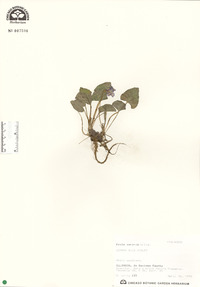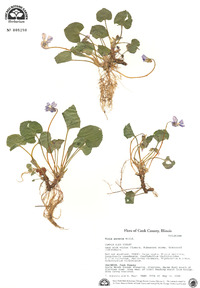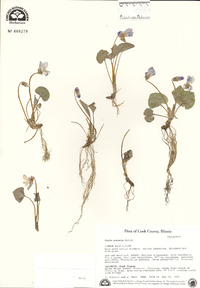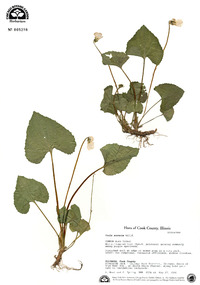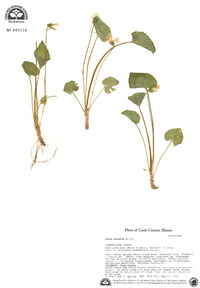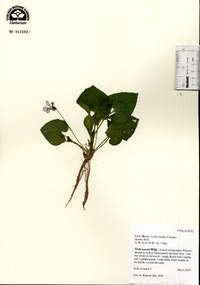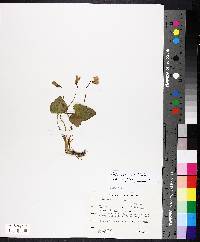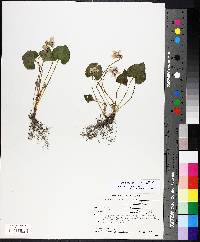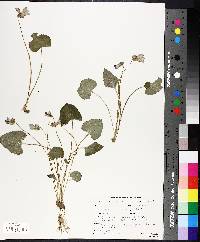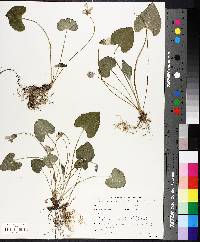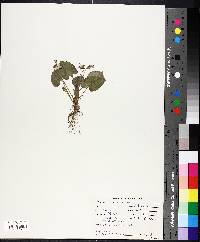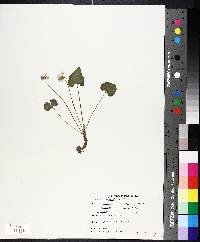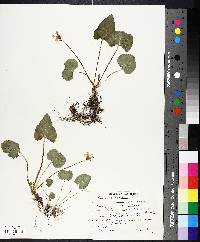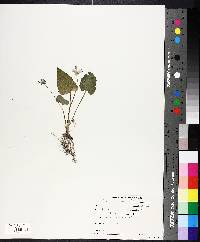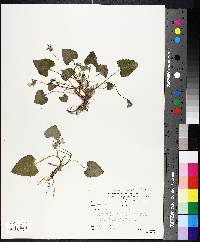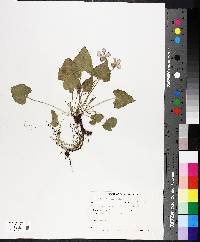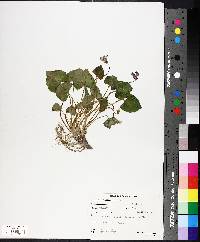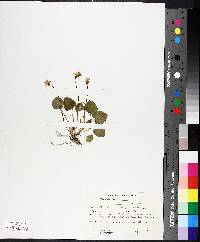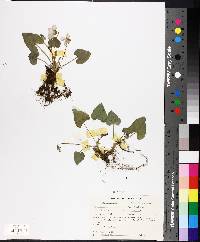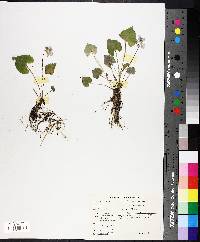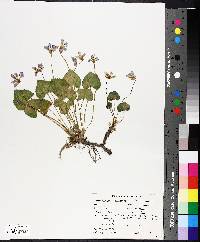
|
|
|
|
Family: Violaceae
Hooded Blue Violet, more...common blue violet, meadow violet
[Viola floridana Brainerd, moreViola latiuscula Greene, Viola palmata var. sororia (Willd.) Pollard, Viola papilionacea Pursh, Viola papilionacea f. albiflora Grover, Viola papilionacea var. papilionacea , Viola papilionacea var. priceana (Pollard) Alexander, Viola priceana Pollard, Viola septentrionalis Greene, Viola septentrionalis var. grisea Fernald, Viola sororia var. incognita J. Lacey, Viola X champlainensis House, Viola X insessa House, Viola X melissifolia Greene, Viola X montivaga House, Viola X napae House, Viola X subaffinis House] |
Plant: perennial herb; to 50 cm tall; stems short, thick rhizomes with long fibrous roots Leaves: simple, basal; blades to 10 cm wide, cordate to reniform, widely ovate to elliptic, triangular to deltate, glabrous to strigose throughout; margins crenate to serrate, ciliate or not; tip acute to obtuse INFLORESCENCE: scapose, the pedicels elongated Flowers: sepal auricles of cleistogamous flowers elongated or not; petals light to dark blue-violet, the lower 3 purple-veined, the lateral 2 white-bearded, the lowest petal sometimes spurred; cleistogamous pedicels prostrate to ascending Fruit: FRUITS 5-10 mm long, glabrous; SEEDS ca. 15-20, usually ovoid, with a prominent caruncle REFERENCES: Little, R. John. Violaceae. 2001. J. Ariz. - Nev. Acad. Sci. Volume 33(1). Perennial herb 8 - 30 cm tall Stem: absent aboveground, leaves and flowers arising independently and directly from rootstock of thick (much greater than 3 mm diameter) rhizomes, but lacking runners (stolons). Leaves: basal, long-stalked, usually hairy (especially underneath and along stalk), prominently toothed, egg-shaped to heart-shaped with indented base and abruptly pointed tip. The leaves are normally wider than long, though sometimes equally wide as long, and the summer leaves are typically 6 - 13 cm wide. Stipules green, less than 1.5 cm long, and fully separate from leaf stalk. Flowers: short-stalked (often shorter than leaves), pale lavender to deep violet (then with darker purple ring at throat), 1.5 - 2.5 cm long, 2 - 3 cm wide, bilaterally symmetric with two upper petals, two lateral petals, and lower petal with base modified into a rounded nectar spur. In the summer, producing horizontal to arching, fleshy stalks terminated by very fertile flowers that do not open (cleistogamous). Sepals: five, green, sometimes bristly on edges, somewhat egg-shaped with blunt tips, and up to 3 mm long ear-like appendages (auricles) at the base. Petals: five, separate, all differently shaped, but somewhat spreading. The two lateral petals have a beard of long (over 1 mm) slender hairs near the base, while the shorter lowest petal is beardless (rarely with a few hairs), and prolonged at its base into a short, rounded spur or sac. Stamens: five, separate, but very tightly arranged so anthers touch as they surround ovary. The filaments are very short (anthers not exposed), and the lower two stamens have spur-like nectaries on their backs that extend into the spur or sac of the lower petal. Pistil: with a single-chambered, superior ovary; and a single style that expands into a short, scoop-shaped stigma. Fruit: a many-seeded, purplish with green flecks, hairless, 0.7 - 1 cm long, ellipsoid to egg-shaped capsule on prostrate stalks. The capsule opens lengthwise from its top to disperse the light brown seeds which have a large amount of oily endosperm, and often an appendage (aril). Similar species: Viola sororia is very similar to V. affinis, but that species has hairless leaves that are usually longer than wide with gradually tapering pointed tips, the flowers are on longer stalks so the flowers are about equal with the leaf tips, the sepals are more lance-shaped with pointed tips, and the spur petal is very heavily bearded with slender hairs. Also similar is V. nephrophylla, but that species also has mostly hairless leaves but with more rounded teeth, the flower stalks extend beyond the leaves, the flowers are dark purple but never have a noticeably darker area in the throat, the spur petal has a very heavy beard, and the capsules, which are entirely green and contain olive-black seeds, are on erect stalks. Another somewhat similar species is V. cucullata, which while sharing the character of a hairless spur petal with V. sororia, has many of the same characters that distinguish V. nephrophylla (long flower stalks, green capsules on erect stalks, olive-black seeds), and further differs by having long-tapering and pointed sepals with longer basal auricles (2 - 10 mm), and the lateral petals have a beard of short, club-shaped hairs. Flowering: April to June Habitat and ecology: Common, in disturbed woodlands, moist or dry forests, floodplains, abandoned fields, lawns, and even degraded prairies. Occurence in the Chicago region: native Notes: This is quite a complex and somewhat variable species in various parts of its range. It is also known to hybridize with several other species in the Boreali-Americanae group. We follow the species concept of Ballard (1994). Adding to the confusion surrounding this species is the fact that several names have been applied to it in the past, including V. septentrionalis, V. latiuscula, V. papilionacea, V. priceana, and even V. pratincola. Etymology: Viola is the classical name for the genus. Sororia means "of sister". Author: The Field Museum Glabrous to often evidently spreading-hairy, acaulescent; rhizome short, stout, oblique or horizontal, sometimes branching to form colonies; lvs all merely crenate-serrate, cordate at base, the blade typically held at an angle to the strongly ascending petiole, ovate to orbicular or reniform, acute to often obtuse or rounded above, the summer-lvs to 13 cm wide; fls seldom elevated much above the lvs, 2-3 cm wide, relatively broad and open, appearing flat-faced; pet relatively wide, deep violet to lavender or white, the 2 lateral ones densely bearded with relatively long hairs (many of them ca 1 mm or more) that are only slightly or not at all expanded upwards; spurred pet glabrous or sometimes bearded, nearly or fully as long as the lateral ones; cleistogamous fls stout, on horizontal to erect peduncles; fr thickly ellipsoid, evidently surpassing the sep; seeds dark brown; 2n=54. Moist or wet places, sometimes in disturbed sites and somewhat weedy; Nf. and Que. to B.C., s. to Fla., Tex., and Calif. Apr.-June. (V. affinis, a form with the spurred pet bearded; V. papilionacea, a subglabrous form; V. priceana, the Confederate violet, with pale gray-blue fls and a conspicuous violet eye; V. novae-angliae, a form transitional to no. 3 [Viola sagittata Aiton]; V. floridana; V. langloisii; V. latiuscula; V. missouriensis; V. pratincola; V. septentrionalis) Gleason, Henry A. & Cronquist, Arthur J. 1991. Manual of vascular plants of northeastern United States and adjacent Canada. lxxv + 910 pp. ©The New York Botanical Garden. All rights reserved. Used by permission. From Flora of Indiana (1940) by Charles C. Deam This is our most common blue violet. Throughout the state in rich, moist or dry woodland and in the open in various habitats. [Viola papilonacea] is probably best considered as a glabrate form of Viola sororia. One of our most common blue violets. Frequent in all parts of the state except the area about Lake Michigan for which there are no records. In moist woodland and clearings and along roadsides. …… Indiana Coefficient of Conservatism: C = 1 Wetland Indicator Status: FAC |
|
|
|

